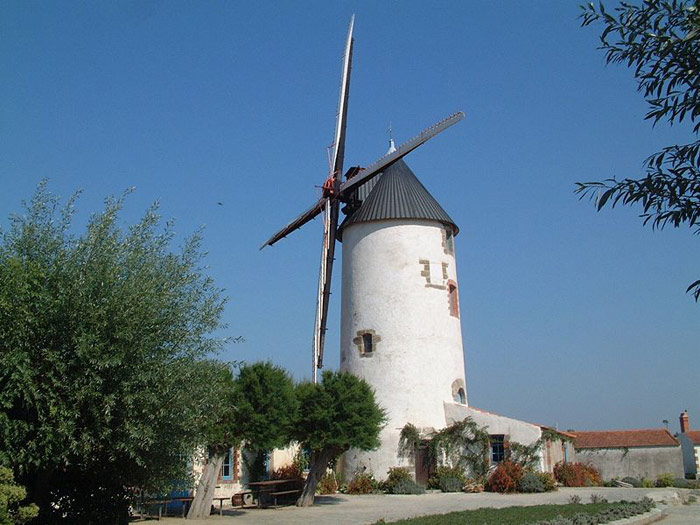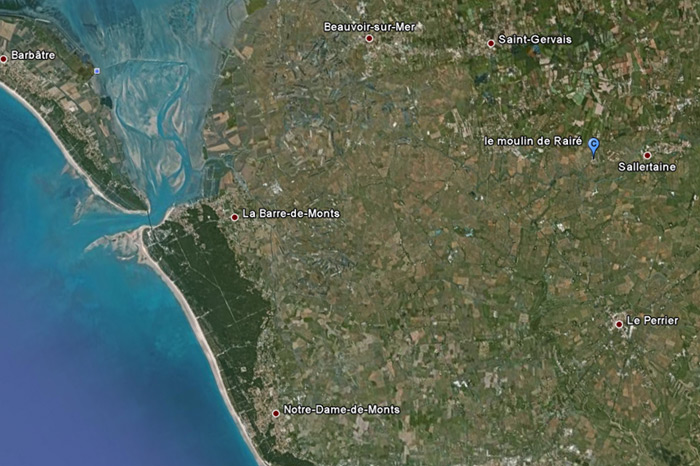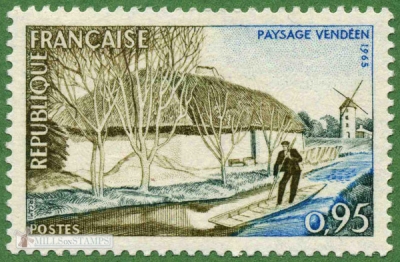-
Definitive issue. Landscapes
France 1965.07.10
In issue: Stamp(s): 3
-
Number by catalogue: Michel: 1518 Yvert: 1439 Scott: 1129
Perforation type: 13x13
Subject:
95 santimes. Vendee* river view with a windmill on a background
Additional:
*The Vendée [vɑ̃ˈde] is a department in the Pays-de-la-Loire region in west central France, on the Atlantic Ocean. The name Vendée is taken from the Vendée river which runs through the south-eastern part of the department.
The department is crossed by four rivers: the Sèvre Nantaise (135 km), the Vendée (70 km), the Lay (110 km) and the Sèvre Niortaise (150 km).
In the Vendée, 31 members, elected through universal suffrage, govern the affairs of the department, with 28 members on the right-wing and 3 members on the left-wing. In the Vendée, this assembly is headed by Philippe de Villiers.
The area today called the Vendée was originally known as the Bas-Poitou and is part of the former province of Poitou. In the south-east corner, the village of Nieul-sur-l'Autise is believed to be the birthplace of Eleanor of Aquitaine (1122-1204) and was part of her kingdom. Eleanor's son, Richard I of England (the Lionheart) often based himself in Talmont. The Hundred Years' War (1337-1453) turned much of the Vendée into a battleground.
Since the Vendée held a considerable number of influential Protestants, including control by Jeanne d'Albret, the region was greatly impacted by the French Wars of Religion which broke out in 1562 and continued until 1598. Eventually King Henri IV issued the Edict of Nantes and the Wars came to an end. When the Edict of Nantes was revoked in 1685, it caused many Huguenots to flee from the Vendée.
It is also remembered as the place where the peasants revolted against the Revolutionary government in 1793. They resented the changes imposed on the Roman Catholic Church by the Civil Constitution of the Clergy (1790) and broke into open revolt in defiance of the Revolutionary government's military conscription. A guerrilla war, known as the Revolt in the Vendée, led at the outset by an underground faction called the Chouans (tawny owls), cost more than 100,000 lives before it ended in 1796.
In 1815, when Napoleon returned from Elba for his Hundred Days, La Vendée refused to recognise him and stayed loyal to King Louis XVIII. General Lamarque led 10,000 men into La Vendée to pacify the region.
In 1850, British author, Anthony Trollope published his book La Vendée, detailing the history of the region and the war. In the preface he pays tribute to Madame de la Rochejaquelein on whose memoirs of the war he based his story.
The Revolt in the Vendée is the subject of Ninety-Three (Quatre-vingt-treize), the last novel by the French writer Victor Hugo.
In the writings of Karl Marx regarding revolutionary struggles in various countries, he uses the term "a Vendée" as meaning "a focus of persistent counter-revolutionary activities".
On the stamp the mill from Rairé, cities of department Vendee is represented.
The arrangement of a mill by Google Earth
See also the FDC of this issueTopics: Mills within the landscapes Windmills



